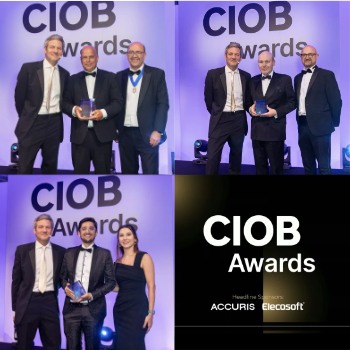Structural Engineers' Climate Action
The six most important things all professional structural engineers should do now. Suggestions from Dr Mike Cook, March 2020:
- Get informed – as a professional engineer you are obliged to develop your skills continuously.
- Design low carbon - track and reduce embodied carbon; rethink the materials you specify.
- Design lean - reduce the quantity of material; avoid over design.
- Design recycled – specify recycled materials and design to allow future re-use.
- Work with your client - influence your brief, develop a sustainability plan, seek opportunities to reduce new-build and maximise retention, adaption and extension of existing buildings
- Get active locally - work with other professionals to help each other, compare progress and learn.
[edit] Get better informed about the climate emergency
- Understand the causes and consequences of carbon emissions for life on the planet.
- Recognise how structural engineering decisions have a direct impact on emissions and the harm they do.
- Understand how you, as a structural engineer, can reduce your professional carbon footprint TODAY.
- Look for information from organisations such as IPCC, CCC, UKGBC, IStructE, LETI and UK FIRES.
- Re-read the Structural Engineering Climate Emergency Declaration (https://www.structuralengineersdeclare.com/) and note the key commitments made.
- Make sure your firm has declared and that everyone knows what this means for them.
[edit] Design low-carbon - reduce embodied carbon through low-carbon design
- Understand where construction activities create carbon emissions through material production, manufacturing and site activities.
- Understand how to measure carbon embodied in a structural design.
- Understand how to reduce embodied carbon through the material choices you make and the way you specify them.
- Select structural materials in ways that you know will reduce embodied carbon.
- Make controlling carbon in your design as important as controlling costs and ensuring safety.
- Make low-carbon important to your clients, team and supply chain.
- Information sources: LETI Embodied Carbon Primer; IStructE Principles for Assessing Embodied Carbon (being published soon).
[edit] Design lean - reduce material use specified in your design
- Design for the least material use whilst retaining safety and buildability.
- Make sure all components are designed for the least material use and are 100% utilised.
- Make sure design loads are fully appraised for the particular building context and use – do not design for unnecessarily high loads “just in case”.
- Consider future strengthening processes as a viable way to future-proof instead of over-design.
- Make sure the client understands that benefits of lean design in terms of cost and carbon.
[edit] Design recycled - reduce material waste and increase the re-use of materials in your designs
- Apply cyclical practices for materials and design and build these into the project team's way of working.
- Seek to use recycled materials to their full in your material specifications and in the choice of components.
- Seek methods of fabrication and construction that allow easy deconstruction and re-use of materials at the end of life.
[edit] Help your client - question your brief and take you client with you
- Provide a structural sustainability report for your project that tracks sustainability targets agreed at the outset and targets achieved on the completion of the project.
- Inform your client about the changes in market expectations that will raise the value of low-carbon ethical construction and reduce the longer-term value of high-carbon construction.
- Seek out opportunities to retain and restore buildings instead of demolishing and replacing them.
- Understand how a development project could become an asset to the planet and regenerative (see https://living-future.org/lbc/).
[edit] Be an active professional engineer
- Engage with the Institution.
- Share your successes and failures.
- Set up local professional groups to exchange information.
- Lobby your local MP for changes in taxation, planning and legislation.
- If you haven’t yet done so, declare a Climate Emergency (https://www.structuralengineersdeclare.com/)
[edit] Related articles on Designing Buildings Wiki
- Architects Declare.
- A zero-carbon UK by 2050?
- Carbon footprint.
- Carbon negative.
- Carbon neutral.
- Climate Change Act.
- Climate Emergency Design Guide: How new buildings can meet UK climate change targets.
- Climate emergency.
- Low or zero carbon technologies.
- Nearly zero-energy building.
- Net zero carbon 2050.
- Net zero carbon building.
- What we need for the journey to net-zero carbon emissions.
Featured articles and news
C20 Society; Buildings at Risk List 2025
10 more buildings published with updates on the past decade of buildings featured.
Boiler Upgrade Scheme and certifications consultation
Summary of government consultation, closing 11 June 2025.
Deputy editor of AT, Tim Fraser, discusses the newly formed society with its current chair, Chris Halligan MCIAT.
Barratt Lo-E passivhaus standard homes planned enmasse
With an initial 728 Lo-E homes across two sites and many more planned for the future.
Government urged to uphold Warm Homes commitment
ECA and industry bodies write to Government concerning its 13.2 billion Warm Homes manifesto commitment.
From project managers to rising stars, sustainability pioneers and more.
Places of Worship in Britain and Ireland, 1929-1990. Book review.
The emancipation of women in art.
Call for independent National Grenfell oversight mechanism
MHCLG share findings of Building Safety Inquiry in letter to Secretary of State and Minister for Building Safety.
The Architectural Technology Awards
AT Awards now open for this the sixth decade of CIAT.
50th Golden anniversary ECA Edmundson awards
Deadline for submissions Friday 30 May 2025.
The benefits of precast, off-site foundation systems
Top ten benefits of this notable innovation.
Encouraging individuals to take action saving water at home, work, and in their communities.
Takes a community to support mental health and wellbeing
The why of becoming a Mental Health Instructor explained.
Mental health awareness week 13-18 May
The theme is communities, they can provide a sense of belonging, safety, support in hard times, and a sense purpose.
Mental health support on the rise but workers still struggling
CIOB Understanding Mental Health in the Built Environment 2025 shows.
Design and construction material libraries
Material, sample, product or detail libraries a key component of any architectural design practice.

























Comments
Consider PAS 20280:2016 Carbon Management in Infrastructure. Reduce carbon, reduce cost.
See https://www.carbontrust.com/what-we-do/assurance-and-certification/pas-2080-carbon-management-in-infrastructure